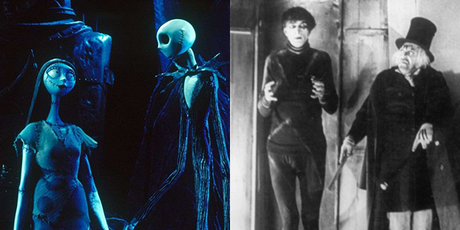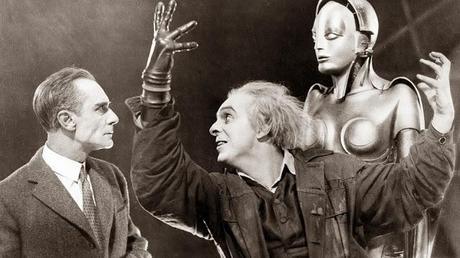
It takes oddballs like Tim Burton and Henry Selick to infuse all of the macabre, sinister aesthetics of post World War I German Expressionist filmmaking into a Christmas film. You have to hand it to them, though! Consider the public response to the film. Audiences have been so receptive that even 20 years after the film’s initial release, the film is still heralded as a classic, and there is more Nightmare merchandise floating around than any goth teenager could ever possibly fit in their bedroom. Just consider all of the animated films that were produced over the course of the past twenty years...how many of them have completely fallen off the face of the earth? Nightmare has stood the test of time.
One of the things that makes the film notable, and also distinguishes Burton’s signature aesthetic in the most broad terms, is the degree to which it borrows from classic German cinema, notably Robert Wiene’s The Cabinet of Dr. Caligari(1920).
Caligari is typically regarded as one of the very first horror films ever made. The script was penned by Hans Janowitz and Carl Mayer, who both served as infantrymen during World War I. They wrote a story about the evil Dr. Caligari (Werner Krauss) who entertains townsfolk with his macabre traveling sideshow attraction: a somnambulist Cesare (Conrad Veidt) who lives in a box and mindlessly obeys the commands of Caligari. In some instances, Caligari even commands Cesare to commit murder. The film was an allegory for World War I, where Caligari represented the German government, and Cesare represented the military -- the sleepwalking children who behave violently at the whims of a warped patriarchal figure.
The film embroiled itself with the emerging trends in German Expressionist painting and printmaking: the asymmetrical architecture, the dramatic black and white makeup, the hand-painted sets, the painted shadows, and treatments of the figure invokes artists such as Max Beckmann, Otto Dix, and even Egon Schiele.
There is a very clear nod to the film in the design and feel of Halloweentown. Burton reportedly established tight parameters for the palette of Halloweentown: it was to be black, white, and orange. Entire sets were covered in plaster and clay and then etched away so that their would be linework on the stages that would give it a more illustrative aesthetic.
The German expressionist aesthetic of Halloweentown is offset nicely by Christmastown, which replicates the aesthetic of classic Christmas TV specials like Rudolph the Red-Nose Reindeer(1964) and How the Grinch Stole Christmas (1966).
 Another piece of German Expressionist filmmaking that Nightmare references is Fritz Lang’s Metropolis(1927), which is largely a reaction to the perceived societal ills that were a product of the industrial revolution. The film forecasts a dystopian future, where the disparity between the quality of life between the rich and the poor is more pronounced than it has ever been, and there are actually sentient robots living as and amongst humans. So much of the film deals with the sort of intense, grim looking mechanical processes, present to some degree in the scenes of Nightmarewhere gifts are being manufactured in a factory...in fact, the factory assembly line trope is present in many of Burton’s films, including Edward Scissorhands (1990) and the opening segment of Charlie and the Chocolate Factory(2005).
Another piece of German Expressionist filmmaking that Nightmare references is Fritz Lang’s Metropolis(1927), which is largely a reaction to the perceived societal ills that were a product of the industrial revolution. The film forecasts a dystopian future, where the disparity between the quality of life between the rich and the poor is more pronounced than it has ever been, and there are actually sentient robots living as and amongst humans. So much of the film deals with the sort of intense, grim looking mechanical processes, present to some degree in the scenes of Nightmarewhere gifts are being manufactured in a factory...in fact, the factory assembly line trope is present in many of Burton’s films, including Edward Scissorhands (1990) and the opening segment of Charlie and the Chocolate Factory(2005). Who would have ever predicted that such a strange film would so captivate the general public? Disney certainly didn’t pounce on the idea right away; Burton had first proposed the project back in the early eighties when he worked as an animator for Disney. Disney executives were initially skeptical, and it wasn’t until Burton had established himself as a filmmaker in his own right that Disney had the confidence to push forward with the film. Even then, Disney decided to release the film under its Touchstone banner, for fear of harming the Disney brand.
Consider what an enormous influence the film has been though! It’s required Christmas viewing for many families, and just in case you haven’t gotten to see Nightmare yet this holiday season, watch it now! There is a special 20th Anniversary DVD/Bluray which just hit the market, and you can also stream the film on Direct TV.
Sometimes, it’s the most seemingly unlikely artistic decision that will enrich a project. The very thing that an overly conservative/unimaginative executive might balk at could be the very secret ingredient that will redefine an entire medium. Such was the case with The Nightmare Before Christmas. And hopefully, it will continue to serve as a point of entry into the annals of German Expressionist filmmaking, which is, in essence, the very history of popular cinema itself.
Other articles by Brandon Engel: 1 - 2 - 3

